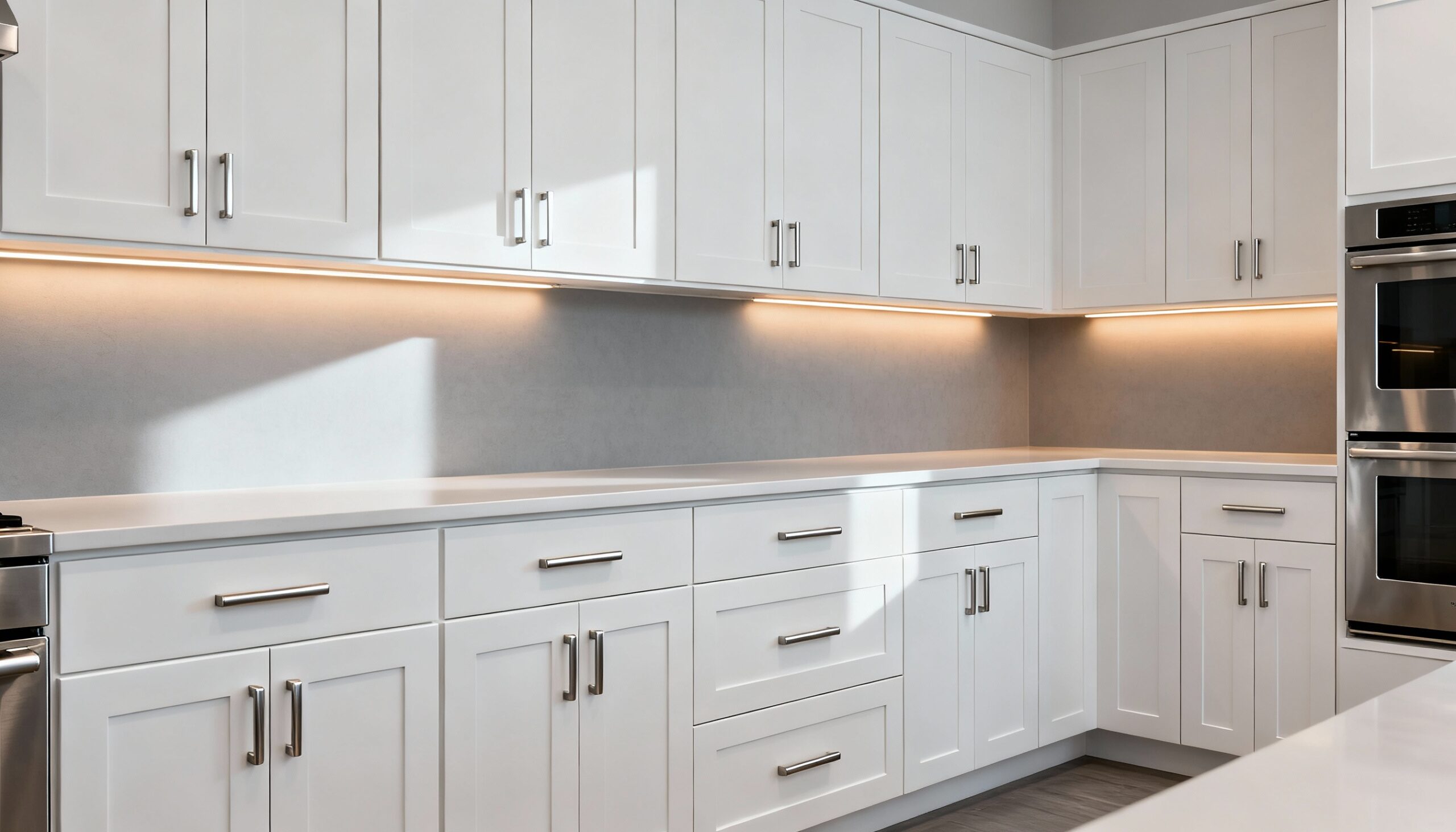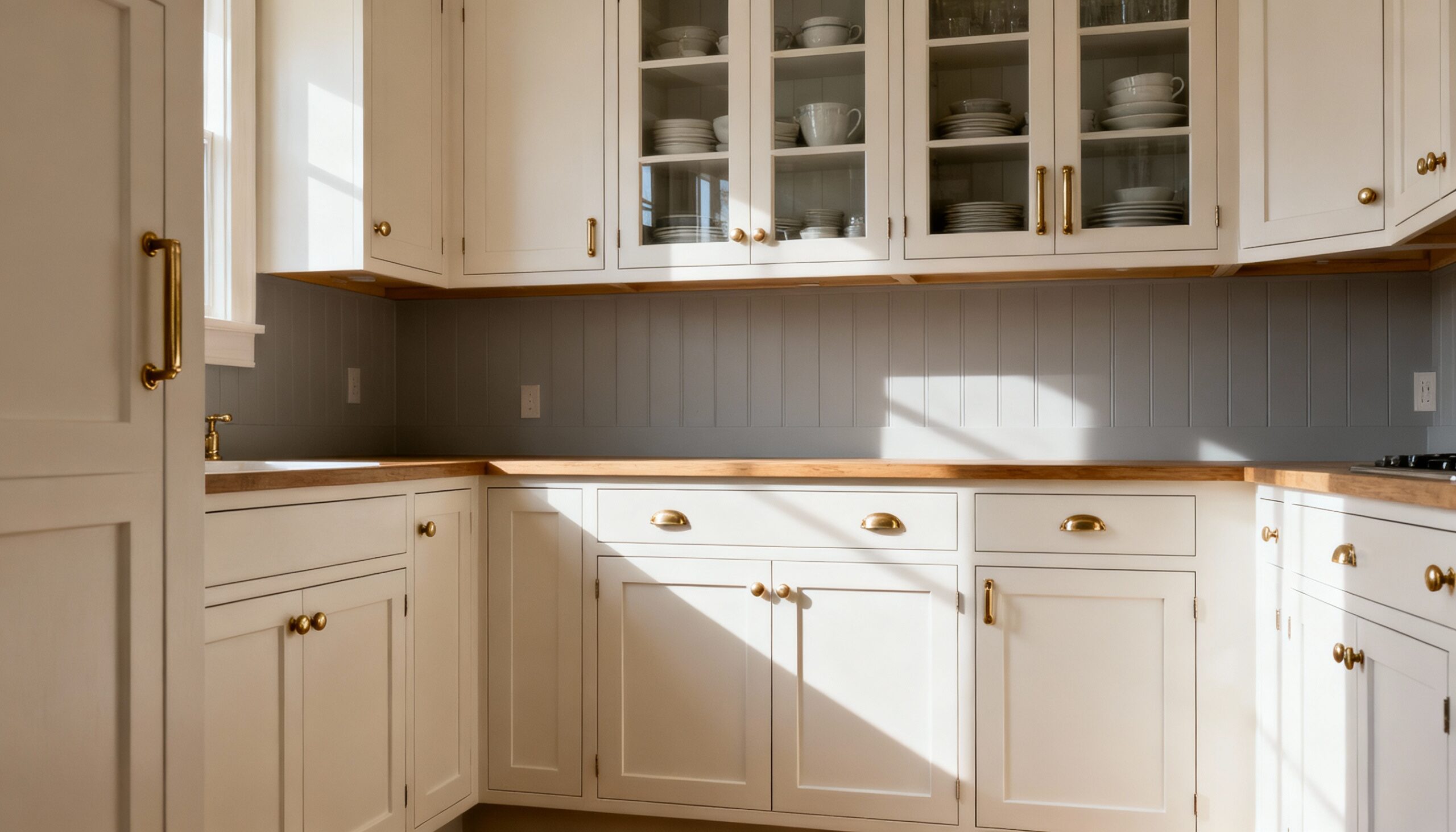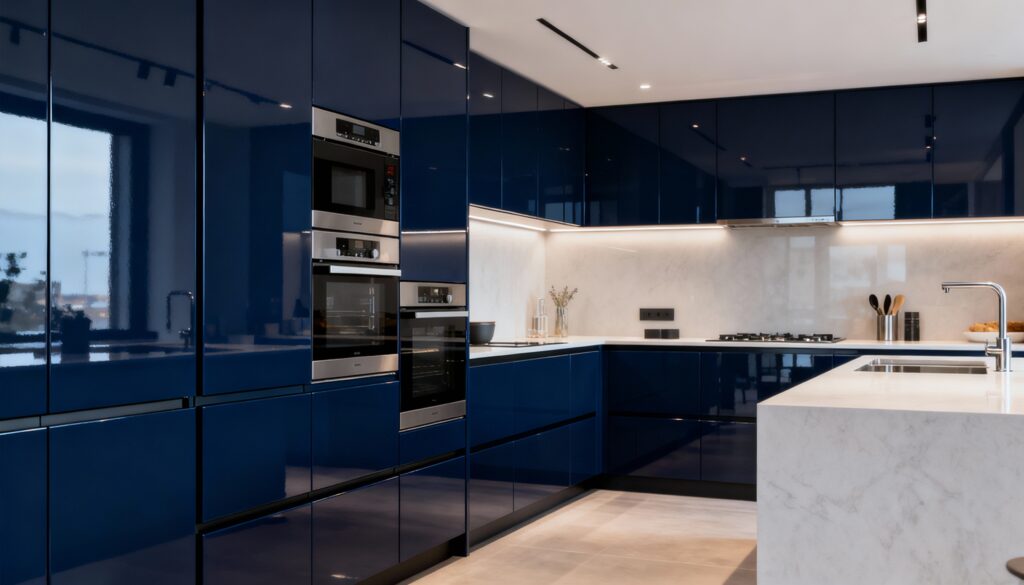Matching kitchen cabinets to your home's architecture is all about producing visual flow from room to room that seems natural. Repeating the lines, ratios, and details of your house's architectural style whether modern, classic, or transitional creates cabinetry that seems on purpose crafted. Then, thoughtful decisions in profiles, finishes, and hardware create a unified appearance that improves both beauty and worth.
Matching Kitchen Cabinets 1: Use Materials That Reflect the Home’s Era
One of the best ways to make a kitchen seem constant, intentional, and aesthetically true to its roots is matching your cabinets with each type of home; every type has its own material tongue. Utilising appropriate materials for your home ensures a natural visual flow throughout the room.
For elder residences including colonial, ancient terrace houses, or early mid-century construction, natural materials including rich stains, unique grain patterns, and traditional painted treatments assist to preserve the elegance and craftsmanship of the period. Timber types like oak, walnut, and maple give legitimacy and go well with vintage architectural elements like architraves, mouldings, and timber flooring. Conversely, smooth, elegant cabinet materials go better with more modern residences.
High-gloss laminates, matte acrylics, aluminium-framed glass cabinets, and engineered wood panels reflect modern design ideas based on clean lines and functionalism. Textured metals, brushed steel accents, concrete-look laminates, and recycled wood fronts mirror the rugged, raw character of the architecture for industrial-inspired dwellings or loft-style spaces. Even Scandinavian-style homes benefit from light-toned woods and soft matte finishes that emphasise simplicity and warmth. Matching goods to the age of your house is about precisely interpreting its character rather than exactly reproducing the past.
Choosing cabinet materials that reflect the architectural heritage of your house enables you to design a kitchen that seems organically integrated rather than pushed, hence raising long-term design value and aesthetic balance. Modern finishes enhance conventional cabinet components to produce a mix of nostalgia and current comfort, hence providing your kitchen a timeless rather than worn-looking appearance.
Matching Kitchen Cabinets 2: Respect the Scale and Proportions of Your Home

Honouring the dimensions and proportions is among the most important tips for matching kitchen cabinets to the aesthetic of your house since the right visual balance ensures your kitchen seems connected, deliberate, and consistent with the other of the area.
Every house has its own inherent rhythm depending on ceiling height, room width, window arrangement, and general architectural style; your cabinets should complement these elements rather than oppose them. In homes with high ceilings, tall upper cabinets or full-height cabinets keep vertical balance and assist to prevent the kitchen from seeming empty or bottom-heavy. In homes with low ceilings, little crown moulding, few upper cabinets, and clean straight horizontal lines, elegant horizontal lines offer height without causing visual clutter.
@ampquartzcabinets Showroom AmpQuartz buka setiap hari tau! So orang JB yang tengah cari kabinet bawah RM9k boleh datang sini cepat! 🥳 #AmpQuartz #KabinetDapur #kabinetmurah #kabinetJB #fyp
♬ original sound – AmpQuartz – AmpQuartz
In tiny kitchens where huge or overly complicated cabinet designs could weigh down the space, proportion is also crucial; smooth profiles, flat-panel doors, and built-in handles help to maintain a bright and airy environment. Providhttps://www.ampquartz.com/safe-kitchen-blueprint-design-tips-for-families/ed they match the architectural scale of their surroundings, large, open-concept homes can house more adventurous cabinet creations like spectacular pantries or huge islands.
Visual consistency is further created by cupboard door widths, gaps between units, and cabinet locations including windows, beams, or structural lines. Matching cabinet sizes to your home's current design helps to save flow, maximise use, and improve general aesthetic harmony, therefore enabling your kitchen to seem like a natural extension of the property rather than a different decoration piece.
Matching Kitchen Cabinets 3: Stay Consistent With Flooring + Countertops
One of the most efficient ways to ensure your kitchen cupboards match the general design of your house is being consistent with your flooring and countertops. Matching your kitchen cupboards, flooring, and counter tops helps to support the architectural style of your home; therefore, it offers a cohesive and intentional look.
Sleek slab cabinets combined with gleaming concrete floors and basic quartz counters help to maintain the elegant, modern aspect defining the style in a modern home. Warm-toned wooden flooring, elegant stone countertops, and a traditional or colonial home, on the other hand, would help to celebrate the architectural history and genius of the house. As misaligned colours might interfere with visual equilibrium, select materials paying great attention to undertones — warm, cold, or neutral.
Think texture as well: rural homes usually look best with matte finishes and natural wood grains; industrial-inspired settings usually prefer rougher textures like distressed wood and metal. Establishing the size and ratio of cabinet lines with those of countertops or floor patterns also contributes to improved architectural movement. Finally consider how your kitchen relates to the surrounding communities.
Consistent flooring helps your kitchen cupboards fit naturally with other areas if your house has open-concept designs found in modern and Scandinavian plans. Besides improving visual harmony, careful integration of these elements reinforces the architectural narrative your house tells, therefore creating a kitchen that seems well-balanced, deliberately connected, and meticulously designed.
Matching Kitchen Cabinets 4: Use Hardware to Tie Everything Together

The right hardware provides the subtle but powerful link that links your kitchen cabinets to the overall architectural style of your home, thereby ties visual harmony everywhere. One of the most effective ways to accomplish this is.
Hardware gives the character life; thus, choosing pulls, knobs, and handles that complement the current architectural details around your house is extremely important even if cabinets give the framework clarity. Selecting sleek, contemporary hardware such as slim matte black handles, brushed nickel pulls, or even handleless push-to-open systems in modern or contemporary settings highlights the architecture's clean lines and simple philosophy.
Curved knobs, beautiful pulls, and warm finishes like brass or old bronze appear more natural for classic or colonial-style homes as they reflect the craftsmanship and artistic features often found in the house's mouldings or doorways. Industrial interiors are aided by raw, exposed materials such worn iron, blackened steel, or hardware with eye-catching geometric shapes that complement the harsh architectural character. Simple spherical shapes, natural wood knobs, or soft matt finishes help to keep the bright, soothing appearance in Scandinavian-inspired rooms.
Beyond looks, hardware also creates harmony by combining form with purpose, so ensuring that every touchpoint seems deliberate and linked. Hardware should speak the same visual dialect as your home's present design language — look at your lighting fixtures, window frames, stair railings, even furniture legs. Chosen with care, cabinet hardware transforms the little element finishing off your kitchen's architectural story.
Matching Kitchen Cabinets 5: Don’t Forget the “Transitions” Between Rooms
One of the most ignored yet crucial design ideas when aligning kitchen cabinets with your home's architecture is giving heed to the transitions between rooms. Whether they happen via a doorway, an open floor plan, or a linking hallway, these changes help to keep visual harmony throughout your house.
A kitchen should flow naturally into the adjacent rooms rather than seem like a wholly different style chapter. Start by looking at the colour and materials utilised in nearby regions. Replicate these aspects in your cabinet finishes or hardware to foster a feeling of continuity if your living area has warm wood tones or matte black accents. Similarly, picking sleek cabinet fronts or muted hues helps keep balance if your eating area favours a minimalistic style.
Your cabinet decisions are also guided by architectural features including ceiling patterns, door frames, and floor patterns. A home with curved arches, for instance, might combine nicely with gently rounded cabinet edges or an island with smooth lines. A house with strong linear beams benefits from streamlined flat-panel cabinetry. Even little transitions count; using comparable trim profiles, consistent lighting temperatures, or complementary countertop materials guarantees that every room seems linked instead of visually broken.
Modern houses call for this approach particularly as open plans require flawless integration. Viewing your kitchen as part of a bigger architectural story lets your furniture naturally complement the personality of your house. Basically, good transitions produce a unified, balanced aesthetic such that the kitchen naturally fits every room it connects with.





